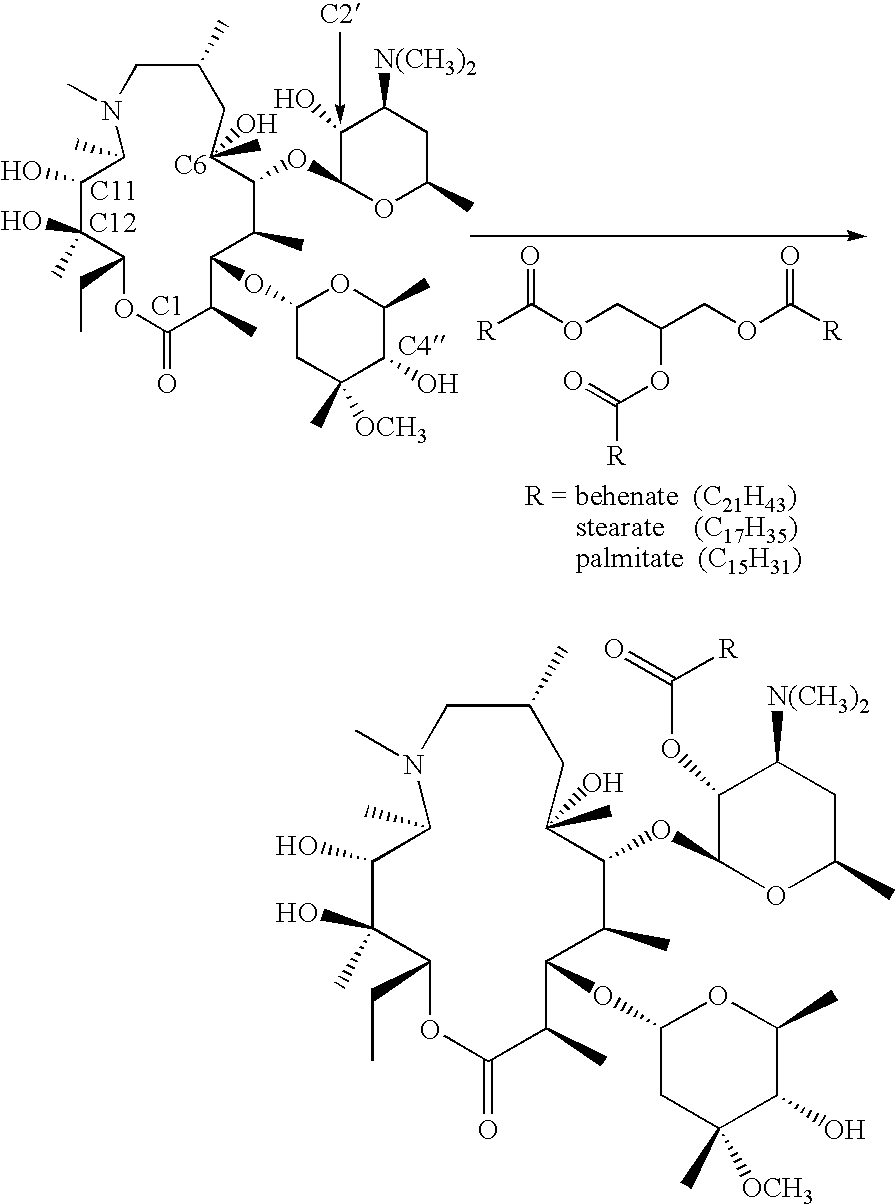Azithromycin multiparticulate dosage forms by melt-congeal processes
a technology of melt-congeal process and azithromycin, which is applied in the direction of biocide, dispersed delivery, antibacterial agents, etc., can solve the problems of affecting the content of the drug, affecting the quality of the product, so as to improve the content uniformity, eliminate the contact of the drug, and improve the effect of azithromycin releas
- Summary
- Abstract
- Description
- Claims
- Application Information
AI Technical Summary
Benefits of technology
Problems solved by technology
Method used
Image
Examples
screening examples 1-3
[0142] The tendency of azithromycin to form esters in melts at different temperatures and for different periods of time was studied. A mixture of glyceryl behenates (13 to 21 wt % monobehenate, 40 to 60 wt % dibehenate, and 21 to 35 wt % tribehenate)(COMPRITOL 888 ATO from Gattefossé Corporation of Paramus, New Jersey), was deposited in 2.5 g samples into glass vials and melted in a temperature-controlled oil bath at 100° C. (Example 1), 90° C. (Example 2), and 80° C. (Example 3). To each of these three melts was then added 2.5 g of azithromycin dihydrate, thereby forming a suspension of the azithromycin in the molten COMPRITOL 888 ATO. After stirring the suspension for 15 minutes, a 50 to 100 mg sample of the suspension was removed from each of the molten samples and congealed by allowing the same to cool to room temperature. With stirring of each suspension continuing, additional samples were collected at 30, 60, and 120 minutes following formation of the suspension. All collected...
screening examples 4-25
[0147] The tendency of azithromycin to form esters in melts at different temperatures and for different periods of time was studied. Screening Examples 4-25 were prepared like Examples 1-3 except that a variety of different excipients, temperatures, and exposure times were used, all as tabulated in Table 3. The chemical makeup of the various carriers screened is as follows: MYVAPLEX 600 is a glyceryl monostearate; GELUCIRE 50 / 13 is a mixture of mono-, di- and tri-alkyl glycerides and mono- and di-fatty acid esters of polyethylene glycol; carnauba wax is a complex mixture of esters of acids and hydroxyacids, oxypolyhydric alcohols, hydrocarbons, resinous matter, and water; microcrystalline wax is a petroleum-derived mixture of straight chain and randomly branched saturated alkanes obtained from petroleum; paraffin wax is a purified mixture of solid saturated hydrocarbons; stearyl alcohol is 1-octadecanol; stearic acid is octadecanoic acid; PLURONIC F127 is a block copolymer of ethyle...
screening example 26
[0150] This example illustrates how the degree of acid / ester substitution can be determined from the Saponification Number for an excipient. The degree of acid / ester substitution [A] for the excipients listed in Table 5 was determined by dividing by 56.11 the Saponification Number for the carrier as listed in Pharmaceutical Excipients 2000.
TABLE 5SaponificationExcipientsNumber[A]*hydrogenated castor oil176-1823.1-3.2cetostearyl alcoholcetyl alcoholglyceryl monooleate160-1702.9-3.0glyceryl monostearate155-1652.8-2.9glyceryl palmitostearate175-1953.1-3.5Lecithin1963.5polyoxyethylene alkyl etherpolyoxyethylene castor oil derivatives40-500.7-0.9polyoxyethylene sorbitan fatty acid45-550.8-1.0esterspolyoxyethylene stearates25-350.4-0.6sorbitan monostearate147-1572.6-2.8stearic acid200-2203.6-3.9stearyl alcoholanionic emulsifying waxcarnauba wax78-951.4-1.7cetyl esters wax109-1201.9-2.1microcrystalline wax0.05-0.1 0.001-0.002nonionic emulsifying waxwhite wax 87-1041.6-1.9yellow wax 87-10...
PUM
| Property | Measurement | Unit |
|---|---|---|
| wt % | aaaaa | aaaaa |
| melting point | aaaaa | aaaaa |
| temperature | aaaaa | aaaaa |
Abstract
Description
Claims
Application Information
 Login to View More
Login to View More - R&D
- Intellectual Property
- Life Sciences
- Materials
- Tech Scout
- Unparalleled Data Quality
- Higher Quality Content
- 60% Fewer Hallucinations
Browse by: Latest US Patents, China's latest patents, Technical Efficacy Thesaurus, Application Domain, Technology Topic, Popular Technical Reports.
© 2025 PatSnap. All rights reserved.Legal|Privacy policy|Modern Slavery Act Transparency Statement|Sitemap|About US| Contact US: help@patsnap.com

